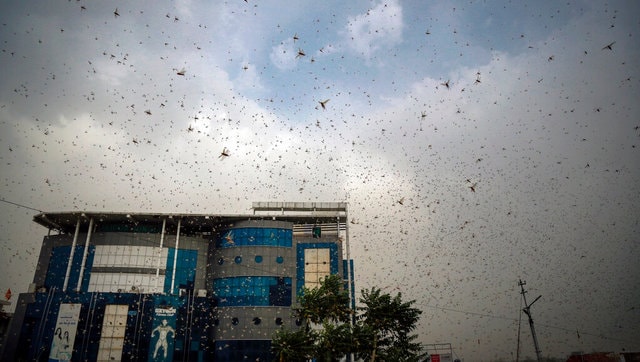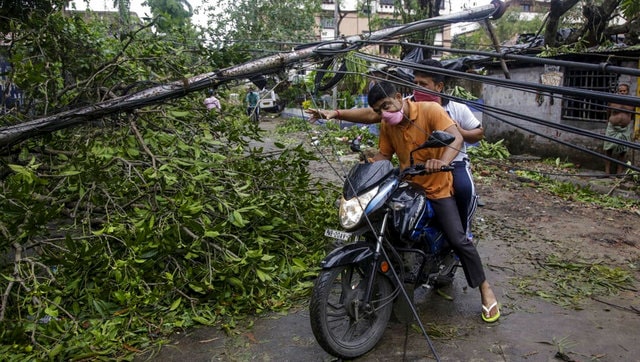Locusts attack, a cyclone, forest fires and heatwave add to India's miseries in the middle of COVID-19 pandemic
by FP StaffLocusts, a global pandemic, ravaging cyclone, a deadly heatwave and raging forest fires have all but crushed India's efforts to get back on track at a time when it is dealing with its worst economic crisis since Independence.

Locusts swarming over city and near by area in Ajmer, Rajasthan. AP
Locust attack in Western India
Just when India was gearing up to resume economic activities and citizens' movement in over 130-billion-strong nation which had ground to a halt two months ago, a new and larger generation of the voracious insects, numbering in the billions, started ravaging parts of western India.
The infestation is a common phenomenon, associated with western Rajasthan and Gujarat from mid-July till November. But an early onset, also ravaging parts that were not necessarily prepared for the crisis could mean added pressure on the already struggling agrarians and could threaten food security of millions of India's poorest.
Exasperated farmers have been banging plates, whistling or throwing stones to try to drive the locusts away, and sometimes even lighting fires to smoke them out. But many are just forced to watch in frustration, with the lockdown, further restricting their access to pesticides and repellents.
Worried farmers say that while Rabi crops that were sown in winter were harvested in the spring, locusts can still damage the cotton crop and vegetables sown in April.
While the overall impact of the infestation is not yet known, authorities estimate the insects have engulfed more than 50,000 hectares (123,5000 acres) of agricultural land in seven of India’s heartland states. A Union Environment Ministry official did agree that it was a very badly-timed "serious infestation" that may lead to serious crop losses.
Roxy Mathew Koll, senior scientist at Indian Institute of Tropical Meteorology and lead author of IPCC Oceans and Cryosphere, blames change in climatic conditions for the onset. She said the outbreak started after warm waters in the western Indian Ocean in late 2019 fuelled heavy amounts of rains over east Africa and the Arabian Peninsula.
"These warm waters were caused by the phenomenon called the Indian Ocean Dipole — with warmer than usual waters to its west, and cooler waters to its east. Rising temperatures due to global warming amplified the dipole and made the western Indian Ocean particularly warm.
"Heavy rain triggers the growth of vegetation in arid areas where desert locusts can then grow and breed. These locusts which migrated to India early this year might have found greener pastures as the pre-monsoon rains during March-May were in excess over north India this year," Koll said.
Throwing light on the role of the government in facing the situation in India, Ajayvir Jakhar, the chairman of Bharat Krishak Samaj (Indian Farmers' Forum), said, "The Central Government has to go beyond giving alerts and advisories on managing the locust outbreak."
"The government should immediately arrange for aerial sprays of pesticides to control the rapidly escalating situation. The states do not have the wherewithal to manage the scale of the outbreak this year," Jakhar said.
Forest fire in Uttarakhand, heatwave ravages North India
At the north of the country's political map, Uttarakhand is devastated by ravaging forest fires which is estimated to have consumed 51.34 hectares of forest cover so far. It was also reported that Kumaon region was among the worst-hit area with almost two dozen incidents of forest fires.
Making the matters worse, north and central India have been reeling under a severe heat wave and temperatures have soared over 47 degrees Celsius at a few places, making the region the hottest on the planet on Tuesday.
Delhi recorded the hottest day in May in 18 years on Tuesday at 46 degrees and the temperatures only marginally subsided on Wednesday with mercury crossing 45 degrees in the afternoon.
Rajasthan reeled under scorching heatwave with the temperature touching 50 degrees Celsius in Churu district. Bikaner recorded maximum temperatures of 47.4 degrees Celsius, Ganganagar 47 degrees Celsius, 46.5 degrees Celsius in Kota and 45 degrees Celsius in Jaipur on Tuesday.
"Due to the prevailing dry north-westerly winds over plains of northwest India, central India and the adjoining interior parts of eastern India, the present heat wave conditions are very likely to continue during next 24 hours," the IMD said on Wednesday.
The IMD, however, forecasts some respite are likely by Friday when western disturbance is likely to cause dust storms and thunderstorms. Western disturbance is a cyclonic circulation which originates in the Mediterranean Sea. Traversing central Asia, it brings rains to the hills and plains when it comes in contact with the Himalayas.
According to World Health Organisation, heatwaves are one of the worst natural calamities but rarely receive adequate attention because their tolls and destruction are not always immediately obvious. In 2019, 65.12 percent of India's population was exposed to temperatures of over 40 degress Celsius between May and June, a report said.

Cyclone ravages West Bengal
Just last week, Cyclone Amphan (pronounced UM-PUN) dealt a heavy blow on West Bengal, already dealing with the onslaught of the COVID-19 pandemic. At least 84 were killed and millions were displaced. The cyclone has now dissipated. But the pandemic hasn’t, and in the aftermath the state faces several challenges.
In West Bengal, one of India’s poorer states, pandemic response was lagging even beffore the cyclone hit the state as it has one of the highest fatality rates from COVID-19 in India. “I have never seen such a disaster before,” said West Bengal Chief Minister Mamata Banerjee.
Now the cyclone has raised fears it could exacerbate the spread of the coronavirus in overcrowded emergency shelters.
Debasis Shyamal, a fisherman, forgot about social distancing. He crammed himself into a government shelter, minutes before Cyclone Amphan crashed into his coastal village in West Bengal last week hurling winds of up to 170 kilometers (105 miles) per hour. He stayed awake in the dark, listening to the carnage outside. “No one was thinking about the virus. We were just trying to stay alive,” he said.
Now as the state recovers slowly from the dual economic blow of a pandemic and cyclone, it faces the threat of a fresh surge in coronavirus cases as jobless migrant workers return to villages from hotspot cities like Mumbai and New Delhi, once the shramik trains and other means of transport resume.
The pandemic has also made evacuations harder since many cyclone shelters were being used for quarantining virus patients. The cyclone has also magnified existing inequalities, with poor families more likely to have stayed in crowded, enclosed shelters, which could be a recipe for spreading the virus.
Dr Anant Bhan, a public health specialist, said authorities needed to simultaneously consider "everyone potentially at risk" while dealing with diseases triggered by the cyclone.
He said that those who took refuge in crowded spaces needed to be tested for the virus, something West Bengal had already been struggling with. “If you don’t have enough tests, you need to look at symptomatic testing,” he said, warning that failing to do so could spread the virus further.
So far, India's confirmed caseload of over 1.5 lakh has been concentrated in cities, and Kolkata is no different, accounting for nearly half of the state's 4,000-odd cases.
Furthermore, the state ravaged by flooding and storms will also need to watch out for other epidemics.
With streets and suburbs flooded, and sanitation systems decimated, the “risk of cholera is very high in urban areas”, said Dr Suman Kanungo, an epidemiologist at the National Institute of Cholera and Enteric Diseases in Kolkata.
He added that authorities needed to ensure that clean water was available to prevent bacterial infections like diarrhea as well.
With inputs from agencies